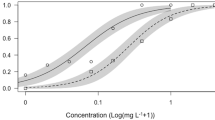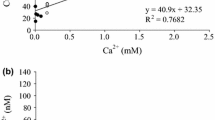Abstract
An acquisition of metal tolerance in cladocerans related to the historical exposure has been well documented for the genera Daphnia and Ceriodaphnia, which are frequently used in ecotoxicological studies. However, small-sized cladocerans are rarely investigated for the inter-clonal variation in metal sensitivity, whereas they often dominate zooplankton community in many lakes and ponds, and even in eutrophicated rivers. We investigated the influence of historical copper exposure on the copper sensitivity of Bosmina longirostris. Copper sensitivity was compared among three clones originating from a site (Lake Yanaka), which located at downstream of historically contaminated river (Watarase River) and clones from five different reservoirs. For reference, the background copper concentration (as Cu2+ activity) at each site and its toxicity to Daphnia magna were estimated by metal speciation and the biotic ligand model (BLM), respectively. Less copper-sensitive Bosmina clones were obtained only from Lake Yanaka, although the background copper concentrations were far below the lethal levels. The results suggested the variability in copper-sensitivity in B. longirostris and its association with historical copper contamination.



Similar content being viewed by others
References
Alonso, M. (1991). Review of Iberian Cladocera with remarks on ecology and biogeography. Hydrobiologia, 225, 37–43.
Baer, K. N., Ziegenfuss, M. C., Banks, S. D., & Ling, Z. (1999). Suitability of high-hardness COMBO medium for ecotoxicity testing using algae, daphnids, and fish. Bulletin of Environmental Contamination and Toxicology, 63, 289–296.
Blanck, H., Wängberg, S. Å., & Molander, S. (1998). Pollution-induced community tolerance—a new ecotoxicological tool. Functional Testing of Aquatic Biota for Estimating Hazards of Chemicals, ASTM STP 988, Philadelphia, 219–230.
Bossuyt, B. T., & Janssen, C. R. (2005). Copper toxicity to different field-collected cladoceran species: intra-and inter-species sensitivity. Environmental Pollution, 136, 145–154.
Candelone, J., Hong, S., Pellone, C., & Boutron, C. F. (1995). Post-industrial revolution changes in large-scale atmospheric pollution of the northern hemisphere by heavy metals as documented in central Greenland snow and ice. Journal of Geophysical Research, 100, 16605–16616.
De Schamphelaere, K. A., & Janssen, C. R. (2002). A biotic ligand model predicting acute copper toxicity for Daphnia magna: the effects of calcium, magnesium, sodium, potassium, and pH. Environmental Science & Technology, 36, 48–54.
Ek, A. S., & Renberg, I. (2001). Heavy metal pollution and lake acidity changes caused by one thousand years of copper mining at Falun, central Sweden. Journal of Paleolimnology, 26, 89–107.
Grosell, M., Nielsen, C., & Bianchini, A. (2002). Sodium turnover rate determines sensitivity to acute copper and silver exposure in freshwater animals. Comparative Biochemistry and Physiology Part C, 133, 287–303.
Haney, J. F., & Hall, D. J. (1973). Sugar-coated Daphnia: a preservation technique for Cladocera. Limnology and Oceanography, 18, 331–333.
Iwasaki, Y., Soya, M., Takasu, M., Zushi, Y., Hayashi, T. I., & Kashiwada, S. (2018). Spatiotemporal changes in water quality along a historically metal-contaminated river: a retrospective analysis of 50 years of monthly monitoring data. Limnology, 19(1), 157–163.
Kamiga, M., & Tagiri, M. (2003). The present pollution of river-bed sediments and soil in the Watarase-river basin and the Miyata-river basin: the pollution level after abandoned working of the Ashio copper mine and the Hitachi mine (in Japanese). The Journal of the Geological Society of Japan, 109, 533–547.
Kilham, S. S., Kreeger, D. A., Lynn, S. G., Goulden, C. E., & Herrera, L. (1998). COMBO: a defined freshwater culture medium for algae and zooplankton. Hydrobiologia, 377, 147–159.
Koivisto, S., Ketola, M., & Walls, M. (1992). Comparison of five cladoceran species in short-and long-term copper exposure. Hydrobiologia, 248, 125–136.
Lopes, I., Baird, D. J., & Ribeiro, R. (2004). Genetic determination of tolerance to lethal and sublethal copper concentrations in field populations of Daphnia longispina. Archives of Environmental Contamination and Toxicology, 46, 43–51.
Lopes, I., Baird, D. J., & Ribeiro, R. (2005). Resistance to metal contamination by historically-stressed populations of Ceriodaphnia pulchella: environmental influence versus genetic determination. Chemosphere, 61, 1189–1197.
Louette, G., & De Meester, L. (2004). Rapid colonization of a newly created habitat by cladocerans and the initial build-up of a Daphnia-dominated community. Hydrobiologia, 513(1–3), 245–249.
Mao, H., Wang, D. H., & Yang, W. X. (2012). The involvement of metallothionein in the development of aquatic invertebrate. Aquatic Toxicology, 110, 208–221.
McIntyre, A. M., & Guéguen, C. (2013). Binding interactions of algal-derived dissolved organic matter with metal ions. Chemosphere, 90, 620–626.
Medina, M. H., Correa, J. A., & Barata, C. (2007). Micro-evolution due to pollution: possible consequences for ecosystem responses to toxic stress. Chemosphere, 67, 2105–2114.
Milne, C. J., Kinniburgh, D. G., & Tipping, E. (2001). Generic NICA-Donnan model parameters for proton binding by humic substances. Environmental Science & Technology, 35, 2049–2059.
Milne, C. J., Kinniburgh, D. G., Van Riemsdijk, W. H., & Tipping, E. (2003). Generic NICA-Donnan model parameters for metal-ion binding by humic substances. Environmental Science & Technology, 37, 958–971.
Mizuno, T., & Takahashi, E. (1991). An illustrated guide to freshwater zooplankton in Japan (in Japanese). Tokyo: Tokai University Press.
Mizuno, T., & Takahashi, E. (2000). An illustrated guide to freshwater zooplankton in Japan (in Japanese). Tokyo: Tokai University Press.
Muyssen, B. T., Bossuyt, B. T., & Janssen, C. R. (2005). Inter-and intra-species variation in acute zinc tolerance of field-collected cladoceran populations. Chemosphere, 61, 1159–1167.
Ohmichi, K., Seno, Y., Takahashi, A., et al. (2006). Recent heavy metal concentrations in Watarase Basin around Ashio Mine. Journal of Health Science, 52, 465–468.
Organization for Economic Co-operation and Development (OECD). (2004). OECD guidelines for testing of chemicals, no. 202: Daphnia sp., acute immobilization test. Paris: OECD.
Ritz, C., Streibig, J. C. (2012). Dose response curves and other nonlinear curves in weed science and ecotoxicology with the add-on package drc in R. Available form: www. bioassay. dk [accessed on 26 March 2013].
Ritz, C., Cedergreen, N., Jensen, J. E., & Streibig, J. C. (2006). Relative potency in nonsimilar dose–response curves. Weed Science, 54(3), 407–412.
Sakamoto, M., Ha, J. Y., Yoneshima, S., Kataoka, C., Tatsuta, H., & Kashiwada, S. (2015). Free silver ion as the main cause of acute and chronic toxicity of silver nanoparticles to cladocerans. Archives of Environmental Contamination and Toxicology, 68(3), 500–509.
Stark, J. D., Tanigoshi, L., Bounfour, M., & Antonelli, A. (1997). Reproductive potential: its influence on the susceptibility of a species to pesticides. Ecotoxicology and Environmental Safety, 37(3), 273–279.
Van Straalen, N. M., & Timmermans, M. J. (2002). Genetic variation in toxicant-stressed populations: an evaluation of the “genetic erosion” hypothesis. Human and Ecological Risk Assessment, 8, 983–1002.
Wheeler, M. W., Park, R. M., & Bailer, A. J. (2006). Comparing median lethal concentration values using confidence interval overlap or ratio tests. Environmental Toxicology and Chemistry, 25(5), 1441–1444.
Funding
This study was supported in part by a Grant-in-Aid for the Strategic Research Base Project for Private Universities, by the Ministry of Education, Culture, Sport, Science and Technology, Japan, 2014-2018 (Grant No. S14111016); and by a Grant-in-Aid for Scientific Research to M. Sakamoto from the Japan Society for the Promotion of Science (Grant No. 17K00584).
Author information
Authors and Affiliations
Corresponding author
Additional information
Publisher’s Note
Springer Nature remains neutral with regard to jurisdictional claims in published maps and institutional affiliations.
Rights and permissions
About this article
Cite this article
Oda, Y., Sakamoto, M., Iwasaki, Y. et al. Inter-clonal Variation in Copper Sensitivity in Bosmina longirostris with Different Exposure Histories. Water Air Soil Pollut 230, 109 (2019). https://doi.org/10.1007/s11270-019-4154-5
Received:
Accepted:
Published:
DOI: https://doi.org/10.1007/s11270-019-4154-5




